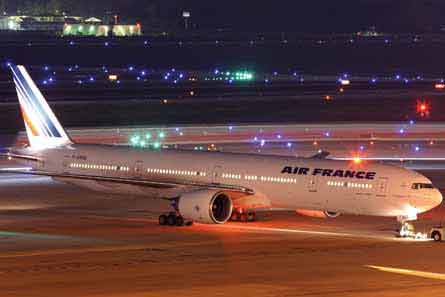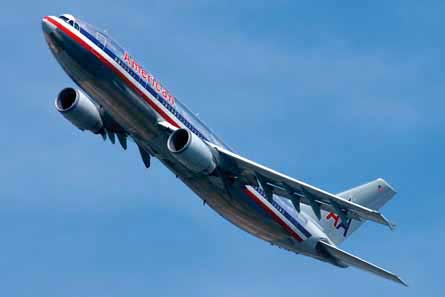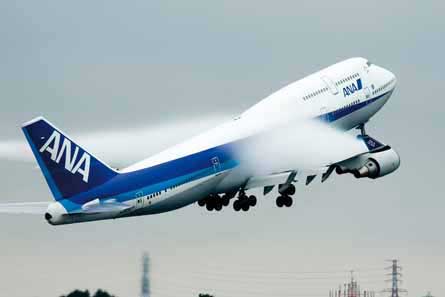Buoyant revenues and traffic failed to lift the dark cloud over US airline finances last year, but carriers in the rest of the world enjoyed a much rosier 12 months
Last year's financial and operating performance for the world's top carriers demonstrated in the starkest terms possible the aching gulf between the haves and the have-nots. The broad canvas shows that the have-nots are the US majors, while the haves are more or less everyone else.
A buoyant revenue and traffic environment in 2005, which has continued so far this year, brought some pain relief to the US industry. Nevertheless, the red ink flowed. Delta and Northwest lost over $2 billion each at the net level, while American and United lost over $500 million - in fact, some fancy book-keeping at United, related to its time in Chapter 11 bankruptcy reorganisation, saw it post a record-breaking net loss of $21.1 billion last year. That included $20.6 billion in extraordinary restructuring charges.
|
|---|
Air France-KLM was of only two airlines to hit $1 billion operating profits |
If this mind-boggling sum is put to one side, according to the World Airline Rankings compiled by sister magazine Airline Business and online news and data service Air Transport Intelligence, the world's top 150 airline groupings still dipped into the red last year, albeit by a slim $100 million.
But the gloom generated by the USA is not at widespread. Every other region was profitable as a whole. Even Latin America, weighed down by the financial liability of Brazil's bankrupt flag carrier Varig, posted half-decent profits at the operating level.
Giovanni Bisignani, International Air Transport Association (IATA) director-general, summed up the views of many at its annual meeting in June: "We are starting to see some light at the end of a five-year tunnel - some cautious optimism."
"The revenue environment is strong," Bisignani added, topping double-digit increases in the past three years. The peak was 2004, when the revenue rise soared to 16%. Last year it cooled slightly to 11.7%. These increases saw global revenues top $400 billion for the first time. Although the final figure saw revenues grow to $440 billion, the operating margin was only 2.5%. "We are moving in the right direction, but nobody should be rushing to open champagne for an industry returning 0.4% of revenues," says the IATA boss.
Net losses
Not since 2000 have US carriers recorded a net profit. Between 2001 and 2005, taking out extraordinary restructuring charges and gains, which can so distort the true financial performance of an airline, US passenger and cargo players posted $35 billion in cumulative net losses, says John Heimlich, vice-president and chief economist of the Washington-based Air Transport Association (ATA).
However dire the past few years have been, deep cost-cutting measures coupled with a rising economy and increasing pricing power, helped drag US carriers back to almost break-even at the operating level. Last year, they posted an operating loss of $130 million, a major improvement over the loss of $2.3 billion in 2004.
And 2006 should see carriers back into profit. IATA predicts that North American carriers will return to profitability, although restructuring losses will limit the reduction in net losses to $4.5 billion.
Heimlich is more optimistic for next year. "I expect the industry to achieve meaningful profits in 2007," he says. "It should be able to push its break-even load factor below 80%, with still-high fuel prices keeping domestic capacity growth rates manageable." Importantly, labour productivity will continue to improve, he said, while airlines reorganising under Chapter 11 bankruptcy protection are expecting to emerge.
One carrier that had been in Chapter 11 for close to four years did finally come out in February. Under the stewardship of chief executive Glenn Tilton, United has slimmed down substantially. During bankruptcy it cut over 2,000 mid-level employees and about 20,000 other workers.
Despite being one of the few carriers to cut its flying markedly in 2005 - by 3.3% in available seat kilometres (ASK) and by 5.8% in passenger numbers - United managed to retain the number six spot in the top 50 in revenue terms. But it was overtaken by both Air France-KLM and Delta in the passenger rankings, falling from second to fourth place. American remains the largest carrier by some distance when measured by ASKs, but Delta carries most people. In 2005 it was the only airline to carry over 100 million passengers, with a modest rise to 118 million.
American is determined to continue its record of being the only US major not to have resorted to Chapter 11 to resurrect its fortunes. Delta and Northwest have each spent just over a year in bankruptcy. Their reorganising has included the usual labour and supplier concessions negotiations, with the former fraught with strike threats and arguments about pension reform.
Expansion drive
Delta's resurgence has featured an ambitious international expansion drive. It is aiming to be the largest global airline between the USA and destinations in Europe, India and Israel. The carrier has shifted widebody jets from domestic to international service to fulfil its mission. Over 50 new international routes have been announced over the past year and 40% of its capacity will be on international routes by next year.
Of all the majors, Continental's solid performance stands out. It made an operating loss of only $39 million last year, while revenues climbed 15% to 411.2 billion. By pursuing the basics of a sound on-time performance and a full on-board service, the Houston-based carrier has returned profitable quarters this year.
Each of the traditional network carriers have simplified and shrunk their fleets, says Heimlich. "Mid-year 2006 figures show American, Continental, Delta, Northwest, United and US Airways had a combined mainline operating fleet that is 23% [816 aircraft] smaller than June 2001. With changes in long-standing work rules, labour productivity has surged 30%." Network carriers shed over 169,000 jobs, a 38% drop over the same five-year period.
Bucking the trend as usual is Southwest Airlines. It made an operating profit of $725 million as revenues rose 16% to $7.5 billion last year. Importantly, its operating margin grew from 8.5% to 9.6%. The low-fare pioneer continues to move deeper into the traditional strongholds of the majors. It went into Denver, a United hub, in early 2006, and has since moved to fill some of the void left by defunct Independence Air at Washington Dulles.
The other US low-cost carrier in the top 50, JetBlue Airways, fared less well. Its operating profit margin flagged from 8.8% in 2004 to 2.8% last year, and it fell into the red to the tune of $20.3 million at the net level. A further loss for the first quarter of 2006 saw the carrier implementing a radical action plan to restore its profitability.
This has included a return to selling its tickets via the global distribution systems, which it has formerly rejected as too costly, in a bid to target corporate travellers, who commonly book through travel agents. It is also selling a handful of Airbus A320s to temper its capacity growth as its takes delivery of its fleet of 100-seat Embraer 190s.
High debt levels
Overall, the strong traffic growth of 2005 is expected to continue in 2006. But Heimlich sounds a warning. "While conditions are certainly improving, debt levels remain precariously high, leaving the airlines especially vulnerable to fuel spikes, recession or exogenous shocks. It will take us several years of profits to dig our way out of this abyss, repairing balance sheets to the point where we can invest adequately for the future."
|
|---|
American remains the largest carrier in terms of available seat kilometres |
With total airline revenues of $154 billion in 2005, the USA easily remains the world's largest air transport market. At $133 billion, Europe's carriers are not far behind. One of the world's most mature markets is also relatively profitable, making $4.8 billion in 2005 with an operating margin of 3.9%. This result is swelled by the low-costs, with Ryanair's $457 million profit making the greatest contribution.
Although revenue growth cooled from a 14.7% peak in 2005 to 9.3% last year, European carriers benefited from the continent's strong economies. "Strong growth in premium traffic is the positive spin-off from a stronger European economy," says Bisignani. "Double-digit growth in Asia-Europe markets contributed significantly."
In Air France-KLM and Lufthansa, Europe boasts the world's two largest airline groups. Both saw strong operating profits, with Air France-KLM one of only two airline groups to top the $1 billion mark. The other was British Airways, while in the cargo world FedEx Express broke through $1 billion by a distance.
The twin strong hubs of Amsterdam and Paris, coupled with cost-cutting synergies of the merged Air France and KLM, helped the combined carrier strengthen its position in 2005. Reinforcing their hub operations at Frankfurt and London Heathrow respectively also helped Lufthansa and BA to perform well. BA in particular is on its way to achieving the 10% operating margin target set by its chief executive Willie Walsh. In 2005 it saw its margin climb to 8.3% from 7.2% in 2004.
Flag carriers
The fortunes of Europe's smaller flag carriers varied. Spain's Iberia, Finnair and THY Turkish Airlines all recorded profits. In THY's case the carrier, which has seen the government reduce its stake in the past two years to just over 50% following public offerings, also saw its traffic jump by over 14%, double the European average.
Elsewhere, several carriers are struggling to restructure their cost bases to compete, particularly against low-cost carriers. SAS Group, for example, found renegotiating pilot and other staff contracts a tall order over the past few years. Chief executive Jorgen Lindegaard's five-year quest to produce a group able to compete head-to-head with low-cost players succeeded in product terms, but the airline remains at a substantial cost disadvantage.
Earlier this year a weary Lindegaard called time on his mission, handing the reins to Mats Jansson, a new name to the industry from the consumer goods sector. Lindegaard was, however successful, in restoring SAS to an operating profit after several years of deep losses.
The deep financial troubles at Alitalia threaten the Italian flag carrier's existence. It may have seen buoyant revenue growth of over 11% in 2005, and its losses have been slashed compared with the disastrous performance of 2004, but the carrier's management failed to agree new concessionary deals with its militant workforce. A fundamental restructuring at state-owned Alitalia appears crucial for the carrier is barred by European Commission decree from going to its shareholder for more state funds.
The picture at Swiss is more hopeful. Gradually coming fully under Lufthansa's wing, the once-expansive airline group that collapsed in the aftermath of the 2001 terror attacks is on the comeback trail. It cut its operating loss to just $11 million in 2005 and is hoping for more than break-even this year.
Although Europe's low-cost carriers are making serious headway in revenue and passenger growth, profitability is not always assured. EasyJet and Ryanair lead the way in profit terms, but few others are making respectable returns.
Air Berlin, which is Europe's third largest low-cost player, was in fact the industry's worse performer of its genre making a net loss of $144 million in 2005. The German carrier went public earlier in 2006, revealing the hitherto private company's financial fortunes for the first time. Air Berlin has a mixture of charter operations from various German cities, plus a fast-expanding pure point-to-point scheduled low-cost operation across Europe. It is already in the top 50 in terms of traffic and could well break into the top 50 revenue ranking this year.
Asia's margins
The world's third largest airline bloc - the Asia-Pacific - produced a result comparable to Europe's in 2005. However, margins at both the operating and net levels at least halved.
"Lower hedging levels than European counterparts meant more exposure to the rising price of fuel," says Bisignani. "At the same time, the rapid development of low-cost airlines is negatively impacting yields on some key regional routes."
Several of the region's most powerful carriers recorded steady profits as revenues grew by a healthy 11.6%. Qantas, Singapore Airlines, All Nippon Airways (ANA) and Cathay Pacific all achieved operating margins in excess of 8%.
Among the top 50, the worst performing Asia-Pacific carriers were Japan Airlines (JAL), Malaysia Airlines (MAS) and China Southern. JAL has been in financial difficulty because of rising fuel costs and a spate of well-publicised safety issues during 2005 that led to travellers defecting to rival ANA.
Of the big three in China, only Air China made a profit, while China Eastern also fell into a loss. China may be a fast-growing market, but soaring traffic is not guaranteed to translate into profits. High fuel prices, tough competition and domestic ticket price restrictions all helped make in hard for China Eastern and China Southern to move into the black.
State-owned and struggling MAS is taking radical steps to return to profitability under the guidance of former Shell executive Idris Jala. This includes withdrawing from the vast majority of its large domestic route network and cutting its workforce by about 30%.
One global market that has risen to prominence after years of being held back by restrictive bilateral air accords is India. Only Air India makes it into the top 50 of the world's largest carriers, with Jet Airways not far from entering the elite group. Jet moved into the international market with services to the UK and South-East Asia in 2005.
As India has opened up low-cost carriers are others are pouring in. The new players include Air Deccan, SpiceJet, Go Air and Kingfisher Airlines with dozens of turboprop and narrowbody jets between them. Jet itself made a move to take over Air Sahara to acquire more airport space and slots, but the deal fell through.
There is also yet another attempt by India's government to merge Air India and Indian Airlines. The idea is to create a true network carrier to compete against India's start-ups and taking on international carriers. However, in India a shortage of airport infrastructure and staff, which puts intense pressure on costs, is making it difficult for all players to turn a profit.
One of the globe's most dynamic regions is the Middle East, led by the steep trajectories of Gulf carriers Emirates, Etihad and Qatar Airways. Emirates continued its record of annual double-digit revenue growth with a 30% rise in 2005 propelling it into the top 20 for the first time. Etihad has yet to make an impression on the rankings, having yet to unveil any formal financial accounts. The meteoric rise of Qatar Airways saw it climb 15 places in the revenue ranking to 71st place after a 46% growth. If it sustains such rises it could well move into the top 50 in two or three years time.
Growth to slow
After two years of double-digit revenue growth, economists expect the pace to slow in 2006 and again next year. Normal economic cycles dictate that the industry will slow further, but opinion is divided over how fast the slowdown will be.
|
|---|
ANA enjoyed an operating margin of over 8% |
Aircraft orders of over $30 billion at this year's Farnborough air show appeared to buck the trend, demonstrating that there are plenty of carriers seeking new and replacement capacity over the next five years or so. Boeing, for example, is bullish about the industry's outlook, believing the current industry cycle could well be different. It is not alone in arguing the industry is entering a kind of super-cycle, which could delay the bottom being reached until the beginning of the next decade.
Much of the damage to balance sheets in the past year or two has been caused by the high price of fuel. And fuel price volatility remains the wild card in predicting whether the industry as a whole will break into profitability this year. It certainly has a fair chance of doing so.
But as IATA's Bisignani points out, any profit will be minuscule compared with the sheer size of the industry. "We are improving, but save the champagne," he says. "To recover the cost of capital and pay a return to investors we need to see profits in excess of $45 billion." This would represent something like a 10% profit margin, a level the industry has never ever achieved.
Source: Flight International


























